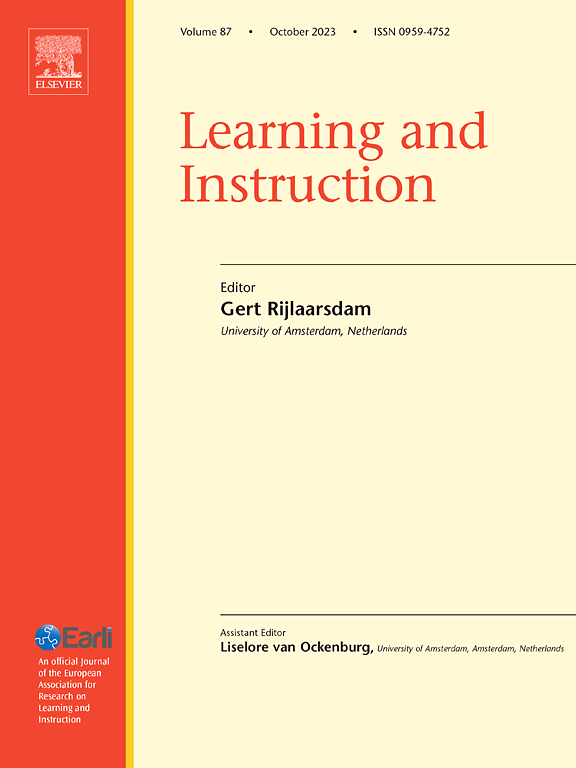Scaffolding of learning activities: Aptitude-treatment-interaction effects in math?
IF 4.9
1区 教育学
Q1 EDUCATION & EDUCATIONAL RESEARCH
引用次数: 0
Abstract
Background
Due to differences in learners' resources in specific learning situations, they may not profit equally from learning activities such as task practice or learning with analogies. Scaffolds can help to adapt learning activities to learners' needs.
Aims
We want to answer the question who benefits from what scaffold when learning about fractions on the number line in digitally-enriched mathematics instruction in the classroom.
Sample
Participants were 332 6th-Graders.
Methods
Dynamic visualizations were used as information-processing scaffold when learning with analogies. During repeated practice, adaptive task difficulty was implemented as motivational scaffold and individualized explanations based on typical mistakes were offered as information scaffold. Students were randomly assigned to one of the scaffold conditions or a control group without scaffolds. As characteristics potentially affecting learning processes during learning activities, we assessed prior knowledge, sustained attention, general reasoning, visual-spatial abilities as well as interest and self-concept in mathematics. These learner characteristics were included as predictors in Generalized Linear Mixed Models, together with the experimental conditions. Due to the nature of the multi-track school system in Germany, advanced placement school (APS; Gymnasium) students and vocational school (VS; Mittelschule) students were considered separately.
Results and conclusion
For APS students, the different scaffolds yielded minimal effects. For VS students, dynamic visualizations could compensate for lower general reasoning and visual-spatial ability when learning with analogies and adaptive task difficulty seemed to successfully counteract lower interest during practice. Instruction can be individualized based on the conditioning of scaffolds on the specific mechanisms underlying different learning activities.
学习活动的脚手架:数学中的能力-处理-互动效应?
由于学习者在特定学习情境中的资源差异,他们可能无法从任务练习或类比学习等学习活动中获得平等的收益。脚手架有助于使学习活动适应学习者的需要。目的我们想要回答的问题是,在课堂上数字化丰富的数学教学中,当学习数轴上的分数时,谁从什么脚手架中受益。样本参与者是332名六年级学生。方法采用动态可视化作为类比学习的信息加工框架。在重复练习中,适应性任务难度作为动机支撑,基于典型错误的个性化解释作为信息支撑。学生被随机分配到支架条件组或没有支架的对照组。作为在学习活动中可能影响学习过程的特征,我们评估了先验知识、持续注意、一般推理、视觉空间能力以及数学兴趣和自我概念。这些学习者特征与实验条件一起被纳入广义线性混合模型作为预测因子。由于德国多轨学制的性质,先修学校(APS;体育馆)学生和职业学校(VS;中小学校(Mittelschule)学生被单独考虑。结果与结论对于APS学生,不同的支架效果最小。对于VS学生来说,动态可视化可以弥补在类比学习和适应性任务困难中较低的一般推理和视觉空间能力,似乎成功地抵消了练习过程中较低的兴趣。教学可以因材施教,这是基于不同学习活动背后的特定机制对支架的调节。
本文章由计算机程序翻译,如有差异,请以英文原文为准。
求助全文
约1分钟内获得全文
求助全文
来源期刊

Learning and Instruction
Multiple-
CiteScore
11.30
自引率
4.80%
发文量
109
期刊介绍:
As an international, multi-disciplinary, peer-refereed journal, Learning and Instruction provides a platform for the publication of the most advanced scientific research in the areas of learning, development, instruction and teaching. The journal welcomes original empirical investigations. The papers may represent a variety of theoretical perspectives and different methodological approaches. They may refer to any age level, from infants to adults and to a diversity of learning and instructional settings, from laboratory experiments to field studies. The major criteria in the review and the selection process concern the significance of the contribution to the area of learning and instruction, and the rigor of the study.
 求助内容:
求助内容: 应助结果提醒方式:
应助结果提醒方式:


